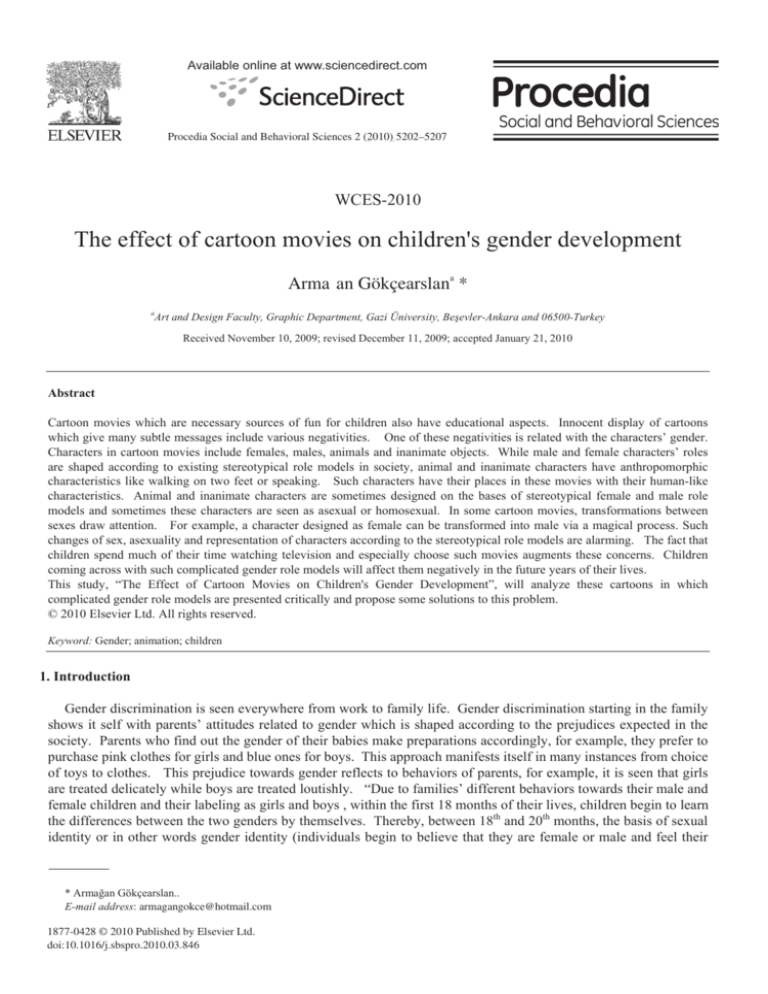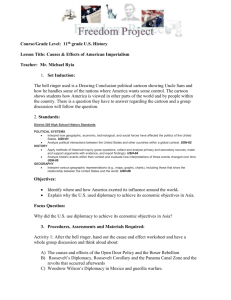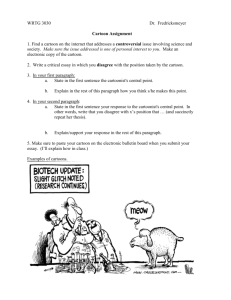
Available online at www.sciencedirect.com
Procedia
ProcediaSocial
Socialand
andBehavioral
BehavioralSciences
Sciences22(2010)
(2010)5202–5207
5202–xxx
WCES-2010
The effect of cartoon movies on children's gender development
Arma an Gökçearslana *
a
Art and Design Faculty, Graphic Department, Gazi Üniversity, Beúevler-Ankara and 06500-Turkey
Received November 10, 2009; revised December 11, 2009; accepted January 21, 2010
Abstract
Cartoon movies which are necessary sources of fun for children also have educational aspects. Innocent display of cartoons
which give many subtle messages include various negativities. One of these negativities is related with the characters’ gender.
Characters in cartoon movies include females, males, animals and inanimate objects. While male and female characters’ roles
are shaped according to existing stereotypical role models in society, animal and inanimate characters have anthropomorphic
characteristics like walking on two feet or speaking. Such characters have their places in these movies with their human-like
characteristics. Animal and inanimate characters are sometimes designed on the bases of stereotypical female and male role
models and sometimes these characters are seen as asexual or homosexual. In some cartoon movies, transformations between
sexes draw attention. For example, a character designed as female can be transformed into male via a magical process. Such
changes of sex, asexuality and representation of characters according to the stereotypical role models are alarming. The fact that
children spend much of their time watching television and especially choose such movies augments these concerns. Children
coming across with such complicated gender role models will affect them negatively in the future years of their lives.
This study, “The Effect of Cartoon Movies on Children's Gender Development”, will analyze these cartoons in which
complicated gender role models are presented critically and propose some solutions to this problem.
© 2010 Elsevier Ltd. All rights reserved.
Keyword: Gender; animation; children
1. Introduction
Gender discrimination is seen everywhere from work to family life. Gender discrimination starting in the family
shows it self with parents’ attitudes related to gender which is shaped according to the prejudices expected in the
society. Parents who find out the gender of their babies make preparations accordingly, for example, they prefer to
purchase pink clothes for girls and blue ones for boys. This approach manifests itself in many instances from choice
of toys to clothes. This prejudice towards gender reflects to behaviors of parents, for example, it is seen that girls
are treated delicately while boys are treated loutishly. “Due to families’ different behaviors towards their male and
female children and their labeling as girls and boys , within the first 18 months of their lives, children begin to learn
the differences between the two genders by themselves. Thereby, between 18th and 20th months, the basis of sexual
identity or in other words gender identity (individuals begin to believe that they are female or male and feel their
* Arma÷an Gökçearslan..
E-mail address: armagangokce@hotmail.com
1877-0428 © 2010 Published by Elsevier Ltd.
doi:10.1016/j.sbspro.2010.03.846
Arma an Gökçearslan / Procedia Social and Behavioral Sciences 2 (2010) 5202–5207
5203
femininity or masculinity, meaning, it is the inner expression of the individuals’ sexual identity) begins to be
constructed (Ersoy, 2009 :189).
Children’s ideas about sexuality becomes mostly clear by the age of 2. “Although they have not constructed a
consistent view of their own gender, they can distinguish females and males and learn to divide the world between
women and men. They define behaviors of woman and man (stereotypes about sexuality)” (Ersoy, 2009 :190). For
example, in a study with children below the age of 2, "children stated to the researchers that girls like to play with
dolls while boys like to play with cars and girls like to cry whereas boy like to push. They divide adults’ activities
as belonging to women and men.
They define colors according to sex”
(Ersoy, 2009 :190).
When children come to the age of 3-4, they are aware of their sex but they are not aware that sex is a permanent
characteristic. According to Kholberg, children “start seeing sexuality as a permanent characteristic and gain this
characteristic completely" (Kail, 2004). In these ages, children can determine their own sex correctly and they are
aware that sex is a permanent characteristic. If the child determines his/her own and others’ sex correctly (labeling),
understands that sex is permanent (stability), sex does not change upon demand (incentive) and comprehends that
sex does not change although hair or clothing style is changed (constancy)” (Dökmen 2004; Greenberg ve di÷er.,
2004).
Gender discrimination starting within the family is consolidated by external factors. Children’s communication
in school and with their friends also leads them to develop prejudiced attitudes towards gender in the years ahead.
One of the most effective factors in children’s internalization of gender stereotypes is media. Katz and Boswell
(1986) stated that both peers and media are more effective than parents in gender development. Peers have more
power over present gender preference while media affects future expectations (Katz ve Boswell, 1986: 112, 103547). Many television programs for children consolidate gender discrimination intensively. It is seen that one of the
two genders is reflected as being dominant while the other is insignificant in the TV programs. Especially, male
characters are more dominant than female characters. Many of TV shows are ordinary people's ordinary lives
reflected on the screen. According to Williams, “most of the television programs are extensions of daily talk”
(Williams,1992). “Shortly, television is the extension of people's common, ordinary feelings and interests on screen
(Mutlu, 1999:12). Thus, it is possible to see society’s ideas, beliefs and traditions in the content of many programs
broadcasted on TV. Gender discrimination in TV programs is actually the reflection of a social problem on the
screen. After the birth of children, gender related labeling begins. For instance, parents are happy to see their
children manifesting socially acceptable behaviors. While behaviors suitable to gender role mode are rewarded,
behaviors which do not mach social expectations related to gender are punished. Generally, social learning
approaches claim that “children's development of characteristics related to gender stems from either rewarding or
punishment of gender typing behaviors or they develop these characteristics by observing role models who had been
rewarded or punished” (Bussey & Bandura, 1999; Huston, 1983; Mischel, 1966, 1970). One of the most viewed
programs by children on TV are cartoons. Cartoons which are tools of entertainment include many incorrect
massages despite their educative aspect. Messages sent related to gender are of great concern since “children at
tender age cannot separate fiction from reality” (Baker & Ball, 1969). “Children at tender age cannot see the
difference between internal and external experiences. They even think that movie characters and toys are real and
alive” (Noble, 1975:84). Children at such ages generally tend to take other same-sex people in their immediate
surroundings as models. For example, girls take their mothers and boys take their fathers as models and they
internalize their behaviors. If there is nobody who can be taken as a model (if parents are deceased or separated)
they can take one of their favorite cartoon movie characters as models. Gender stereotypes attached to cartoon
movie characters come into issue in terms of children who do not know the difference between reality and fiction.
Children taking cartoon characters designed according to the customary gender roles as models can affect their
future life negatively. “True representations of women and men improves healthy growth while nonrealistic
stereotypical representations would cause negative effects on children viewers” (Remafedi, 1990:60). According to
Rosenkrantz, Vogel, Bee and Braverman (1968:287-295), “stereotypical gender role models are especially
responsible for he negative views of young women.”
5204
Arma an Gökçearslan / Procedia Social and Behavioral Sciences 2 (2010) 5202–5207
Figure 1. Characters of Animation Called Smurf
When cartoon movies are examined, it is seen that the number of male characters are more than females.
According to a research report in 1981, Barcus (1983) “realized that 75% of characters in children’s TV shows are
male while 21% are female”. Thompson and Zerbinos examined 175 cartoon movies in the cable and normal TV
and reported that “the number of males among protagonists is more than females by one third while the number of
other male characters are nearly one fifth more than females.”(Thompson & Zerbinos, 1995:651-673). The Smufs
(Image 1), which was designed by a Belgian caricaturist called Peyo and transformed into cartoon later in America,
can be assessed as the most stunning example of this approach since there were 90 male characters while there was
only one female character called Smurfette. The reason of male characters’ number being higher than females is
that cartoons are mostly viewed by boys. According to the vice president of CBS, “boys are always dominant in
children’s TV” (Poltrack, quoted in Carter, 1991, p. C18). TV channel directors express that programs are made for
boys. The reason for that is “the number of male viewers between the ages of 2 and 11 exceeds females in Saturday
mornings. If a program is successful it should be attractive for boys since they don’t watch programs inclding
female protagonists while girls watch programs including male protagonists” (Thompson ve Zerbinos, 1995:653).
One of the researchers handling gender discrimination in cartoon movies from a critical view is Streicher.
According to Streicher (1974: 125-129) assessing the difference of roles given to male and female characters and
negative representations of female characters, “Generally, female characters are less than males in cartoon movies,
they are shown less on screen, they do not have the leader role frequently, they are not very active, they have fewer
responsibilities, they are less bouncing and much more childish than males. Mothers work at home alone and men
do not interfere with house work. Girls are shown doing activities like cheer leaders do and the activities are
mimicked by dogs and pets.”
Male characters are attached more importance in cartoon movies. Male characters are shown as being more
skilled, leading, able to express ideas, threatening and furious than females. On the contrary, female characters are
shown as being more compassionate, in need of protection and busy with ordinary things than male characters”
(Oliver ve Green, 2001:68). There are innumerable cartoon movies designed with this view. One of these cartoon
movies is Pok’emon which was firstly designed as a game and then transformed into an anime series in 1995.
Pok’emon series teach children that nontraditional gender roles are bad. “Pok’emon series seems to reflect femalemale vs. good-evil characters in an equal way while it is the male and good character which is the most important
and distinctive one. Besides, children had difficulties in giving even one name among the female characters””
(Ogletree, Martinez, Turner, Mason, 2004:858).
Women’s representation at low status especially reveals itself in the job they do. Many female characters in
cartoon movies are reflected either as sexual objects or as being unemployed. Very few of them have jobs and these
are generally the ones carried out within house, Very few of them have jobs and these are generally the ones carried
out within house and insignificant. Female characters are rather reflected as house wives, mothers, girl friends,
grandmothers, aunts, evil man’s daughter, maids, nannies, nurses, teachers, secretaries, waitresses, singers, movie
stars, TV reporters, circus member and member and wizard. “While only 13% of female characters in cartoon
movies have jobs male characters have never been shown as caretakers” (Thompson ve Zerbinos, 1995:669). This,
of course, is suitable the data of the real world. Today many women lack jobs as a source of income and most of
them only deal with domestic work. One of the most important factors affecting choice of profession is family
attitude. Even the toys bought at the early ages of the childhood affect children’s choice of profession. For
example, girls get make-up materials, ovens, refrigerators, dinner sets etc. while boys get more complicated toys that
improve intelligence.
Arma an Gökçearslan / Procedia Social and Behavioral Sciences 2 (2010) 5202–5207
5205
Priority of male characters in leading roles more than female characters is another point that attracts attention.
Male leaders come into prominence in terms of many aspects. For example, male characters talk and appear more
on the screen. Male leader characters roles are different from leading females. “Leading male characters are more
free, honorable, attractive, athletic, pretentious and responsible than females. Conversely female characters are
more emotional, friendly, romantic, compassionate, fragile, mature and domestic” (Thompson ve Zerbinos,
1995:668). These are all, naturally, the conventional characteristics of females and males. Representation of leader
male characters does not always reflect their positive characteristics. “Although male characters seem to be more
skilled, ambitious, leading, successful and brave they re also shown as brave victims, committing verbal or physical
crimes, mostly more prone to boast, interrupting others talk, insulting, threatening, mocking and giving orders other
people” (Thompson ve Zerbinos, 1995: 668). Leading female characters on the other hand are not reflected as being
far from ordinary stereotypes of gender roles. Generally, leading female characters “request security, are rewarded
by others, are in need of help, and other female characters are busy with ordinary tasks like serving or providing
something and they are praised for doing these tasks (Thompson ve Zerbinos, 1995: 668). Besides, "female
characters are reflected as less sophisticated" (Thompson ve Zerbinos, 1995:668).
Studies show that unequal representation of women and men is detected by children. “Both male and female
children between the ages of 8 and 13 detected that cartoon characters manifest conventional gender roles” (Mayes
ve Valentine, 1979:41-50).In the interviews carried out after cartoon movie sessions Õt is revealed that girls and boys
detected gender discrimination. Boys described male characters with phrases like ‘they chase bad guys’, ‘get into
trouble’ or ‘made the chest fall on them’ as being aggressive and active" (Thompson ve Zerbinos, 1997:428). Girls'
comments were also similar and they related male characters with aggression and violence. Girls used phrases like “
‘they think they are smarter’ and ‘they try to catch girls’” related to boys. (Thompson ve Zerbinos, 1997:428) Boys
view towards girls are as follows: “girls ‘ask boys out’, girls 2do what boys say’, girls 'are excluded from games’,
girls ‘are not very adventurous’, girls ‘are mocked by boys’ and girls ‘want kisses’” (Thompson ve Zerbinos,
1997:428). Perception of female characters in cartoons by girls is a reflection of the conventional gender role model.
Girls expressed that, "female characters are domestic, they play with dolls, wear pretty clothes and fancy up and run
after boys” (Thompson ve Zerbinos, 1997:428). They also said that female characters do housework, they are very
kind and apologize very frequently. Besides, children detected hat male characters are more than female characters
in number.
Boys’ and girls’ choices of tv programs also differ. Girls generally prefer watching cartoon movies with
emotional and romantic content while boys prefer watching the ones with violent content. The reason for that is two
genders have different emotions and ideas. Family and environment have very important effects on children’s
emotional development. “Parents discouraging boys from displays of sadness and fear, and girls from displays of
anger and aggression (Block, 1973, 1978:512-526)” lead stereotypes of emotions appear to develop early’’.
(Birnbaum et.al., 1980: 435-443). Reactions and inclinations shown in cartoon movies reflects stereotypes of
emotions developed with the attitude of the family. “Females should be more likely to report enjoyment of
entertainment that is likely to elicit “female appropriate” emotions (e.g., sad films, romance), whereas males should
be more likely than females to report enjoyment of entertainment that is likely to elicit “male appropriate” emotions
(e.g., violent films, action films) (Oliver ve Green, 2001: 71). Studies show that there are some improvements about
gender discrimination in cartoon movies. While in 1970s and before female and male cartoon characters manifest
common gender roles, especially after 1980s some changes can be seen in thro les of female and male characters.
According to Thompson and Zerbinos (1995) “more recent cartoons (after 1980s) include less gender stereotypes
according to the ones in the past (before 1980s)”. Another researcher who is aware of the improvement is Downs.
Downs (1981) reached to the result that “representation of stereotypical gender roles decreased in some TV
programs”. Similarly, Vande Berg and Streckfuss (1992) also detected some improvement in terms of the number
of females shown on screen and their jobs”. Bretle and Cantor (1988) observed that “there is a tendency towards
equal representation of women and men” and Signorielli ve Bacue (1999) also expressed that “although
representation of womwn is still not enough there is an improvement”. There had been an important differentiation
in representation of female characters’ gender role in the cartoons after 1980s. For example, “female characters
were more independent, were more independent, pretentious, clever, skilled, responsible and more helpful, stronger
and braver, less emotional, compassionate, sensitive and concerned compared to the past. Besides, female
characters were reflected as being more directive and helpful and as solving more problems compared to the past”
(Thompson ve Zerbinos, 1995:670) 670). There are also some changes in the representation of male characters.
5206
Arma an Gökçearslan / Procedia Social and Behavioral Sciences 2 (2010) 5202–5207
After 1980, male characters in cartoons began to be related with behaviors including violence less. Male characters
“boast less. We could not see ale characters do ordinary tasks or gossip but we do now.” (Thompson ve Zerbinos,
1995:670).
Figure2. Ranma 1/2
Another problem related to gender is inter-sexual transformation. In some cartoons females turn into males or
males turn into females. Such transformations cause anxiety for children in development who don’t know the
difference between reality and fiction. Ranma ½ (1987–1996), which was first designed as a comic book (manga) by
its creator Rumiko Takahashi, is one of the cartoons including inter-sexual transformation. In this cartoon, leading
character Ranma Saotome (Image 2) is doomed to transform between male and female back and forth because of a
curse. These transformations are out of Ranma’s will. While practicing martial arts with his father, Ranma drops
to a magical fountain and because of the curse in water he transforms into female when he contacts cold water and
transforms back to male when he contacts hot water. Ranma’s father turns into a magical panda after dropping into
the fountain. His transforming back to normal is only possible by contacting with hot water. The most critical
point of the cartoon is not the fathers condition but Ranma’s inter-sexual transformation. During this
transformation, Ranma’s change into female is represented as humiliating. “Being male is the norm and being
female (just like being a pig or panda) is a characteristic like others which symbolizes a difference. Morevoer, being
female is coded as being more humiliating than being a panda or a pig” (Napier, 2008: 70). As Rebeca Bell, doing
research on androgenity and dressing opposite sex clothes, claims “Imitating women includes an anxiety about loss
of power, since this generally means men’s obligation to identify with a person at a lower status.” (in Napier, 2008:
70) 70). During the cartoon transforming into female is emphasized as humiliating. For example, in the first
episode, when his father throws Ranma to the lake he says: “You dishonored this family” In the same episode his
father yells at him stronger: “Ranma you now talk like a girl” Ranma in female for reflects a problem. “She is
weaker than male Ranma, a failure in his father’s eyes. 70).” The most ominous of those fears is, as literature
researcher Eve Sedgewick says, “homosexuality panic”, the fear of heterosexual man to be homosexual” (in Napier,
2008:71). In some cartoons, there are some asexual characters. Among such characters there is a cartoon called
Teletubbie which has been very popular among children in recent years. The characters in this cartoon reflect
neither male nor female characteristics. Tese characters without female or male characteristics should be handled
with their negative and positive aspects. Asexuality in cartoons can be interpreted as a positive approach. Because,
rather than showing one sex as being dominant over the other, asexual characters can be more positively effective in
children’s future choices. Rather than being exposed to the dominance of one sex over the other and internalize
conventional gender role model , asexual character can help children to refrain from developing prejudices about
gender. The negative aspect of asexuality can reveal itself in cases where there are no real female or male
characters in children’s life. For example, if one of the parents is deceased or they are separated and there is a
communication problem, children can take any of their favorite cartoon characters as model. The model character
being asexual can cause confusion in children in terms of gender.
2. Conclusion
Many TV programs reflecting the daily experiences of people includes gender discrimination which is a social
problem. Gender discrimination is not a problem which is solely seen in children’s programs. It is seen that females
Arma an Gökçearslan / Procedia Social and Behavioral Sciences 2 (2010) 5202–5207
5207
are being represented weaker compared to males in terms of many aspects in TV programs viewed by adults. In
this study, cartoons among the TV programs for children had been handled. Under their innocent appearance,
cartoons, including many wrong messages, had been observed as transferring gender stereotypes. Especially in
cartoons before 1980, female characters had been shown at lower status in terms of profession than males. Male
characters were more in number and used to appear more frequently on screen. Males were prioritized. Children at
tender ages are exposed to unequal representations of gender. Although there is little improvement in representation
of female characters, it can not be claimed that this problem is completely solved. Gender discrimination in
cartoons is ominous since it is inevitable for children, who are not aware of the difference between reality and
fiction, to internalize stereotypes related to gender roles in cartoons. Many negative images reflected on screen are
in fact inputs from the real life. Female characters’ representation in active positions in work life can provide
reduction of misrepresentations. Producers’ careful approach to this subject can also help children make right
choices in the future.
References
Baker, R. K., & Ball, S. J. (1969). Mass media and violence: A staff report to the National Commission on the Causes and Prevention of
Violence, 9, Washington: Government Printing Office.
Barcus, F. E. (1983). Images of life on children's television: Sex roles, minorities, and families.New York: Praeger.
Birnbaum, D. W., Nosanchuk, T. A., & Croll, W. L. (1980). Children’s stereotypes about sex differences in emotionality. Sex Roles, 6, 435–443.
Block, J. (1973). Conceptions of sex role: Some cross-cultural and longitudinal perspectives. American Psychologist, 28, 512–526.
Block, J. H. (1978). Another look at sex differentiation in the socialization behaviors of mothers and fathers. In J. Sherman & F. L. Denmark
(Eds.), The psychology of women: Future directions of research. New York: Psychological Dimensions.
Bussey, K., & Bandura, A. (1999). Social cognitive theory of gender development and differentiation. Psychological Review, 4, 676–713.
Downs, A. C. (1981). Sex-role stereotyping on prime-time television. The Journal of Genetic Psychology, 138, 253-258.
Dökmen, Z. Y. (2004). Toplumsal Cinsiyet, Sosyal Psikolojik AçÕklamalar. østanbul: Sistem YayÕncÕlÕk.
Ersoy, Ö. A. (2009). Erken Çocukluk Döneminde Cinsel Geliúim ve E÷itimi. østanbul: Kriter YayÕnlarÕ
Greenberg, J.S., Bruess, C.E. ve Haffner, D. W. (2004). Exploring The Dimension of Human Sexuality (Second Edition). Sudbury, MA: Jones
and Barlett Publishers.
Huston, A. C. (1983). Sex-typing. In P. H. Mussen (Series Ed.) & E. M. Hetherington (Vol. Ed.), Handbook of Child Psychology (Vol. 4, 4th ed.,
pp. 387–467). New York:Wiley.
Kail, R. V. (2004). Children and Their Development (Third Edition). New Jersey: Pearson Prentice Hall.
Katz, P Q., & Boswel, S. (1986). Flexibility and traditionality in children's gender roles. Genetic, Social, and General Psychology Monographs,
112, 103-547.
Mayes, S. L, & Valentine, K. B. (1979). Sex role stereotyping in Saturday morning cartoon shows. Journal of Broadcasting, 23, 41-50.
Mischel, W. (1966). A social-learning view of sex differences in behavior. In E. E. Maccoby (Ed.), The development of sex differences (pp. 56–
81). Stanford: Stanford University Press
Mischel,W. (1970). Sex-typing and socialization. In P. H. Mussen (Ed.), Charmichael’s manual of child psychology (Vol. 2, 3rd ed., pp. 3–72).
New York:Wiley
Mutlu, E. (1999). Televizyon ve Toplum. Ankara: T.R.T YayÕnlarÕ
Napier S. j. (2008). Anime Akira’dan Howl’Õn Hareketli ùatosuna. østanbul: Es YayÕnlarÕ.
Ogletree S. M. & Martinez C. N. & Turner R. T. & Mason B. (2004). Pok´emon: Exploring the Role of Gender1 Plenum Publishing Corporation
Oliver M. B. & Stephen G. (2001). Development of Gender Differences in Children’s Responses to Animated Entertainment Plenum Publishing
Corporation
Remafedi, G. (1990). Study group report on the impact of television portrayals of gender roles on youth. Journal of Adolescent Health Care, 11,
59-61.
Rosenkrantz, P., Vogel, S., Bee, H., & Braverman, I. (1968). Sex-role stereotypes and self-concepts in college students. Journal of Consulting and
Clinical Psychology, 32, 287-295.
Signorielli N.,& BACUE, A. (1999). Recognition and respect: Acontent analysis of prime-time television characters across three decades. Sex
Roles, 40, 527–544.
Streicher, H. W. (1974). The girls in the cartoons. Journal of Communication, 24(2), 125 129.
Thompson T. L. & Zerbinos E. (1995). Gender Roles in Animated Cartoons: Has the Picture Changed in 20 Years? 1. Plenum Publishing
Corporation
Thompson T. L. & Zerbinos E. (1997).Television Cartoons! Do Children Notice It's a Boy's World? Plenum Publishing Corporation
Thompson, T. L., & Zerbinos, E. (1995). Gender roles in animated cartoons: Has the picture changed in 20 years? Sex Roles, 32, 651–673.
Vande B., L. H., & Streckfuss, D. (1992). Prime-time television's portrayal of women and the world of work: a demographic profile.
Journal of Broadcasting and Electronic Media, 36, 195-208.
Williams R. (1992). Television: Technology and Cultural Form. London: University Pres










